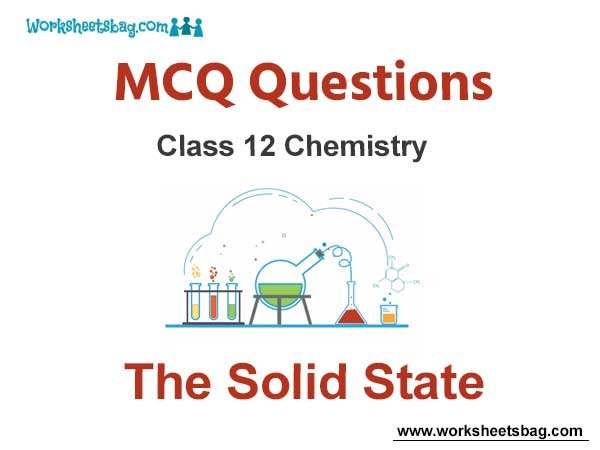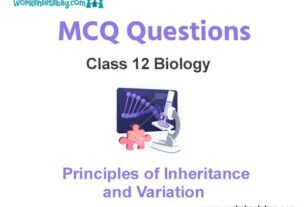Please refer to The Solid State MCQ Questions Class 12 Chemistry below. These MCQ questions for Class 12 Chemistry with answers have been designed as per the latest NCERT, CBSE books and syllabus issued for the current academic year. These objective questions for The Solid State will help you to prepare for the exams and get more marks.
The Solid State MCQ Questions Class 12 Chemistry
Please see solved MCQ Questions for The Solid State in Class 12 Chemistry. All questions and answers have been prepared by expert faculty of standard 12 based on latest examination guidelines.
Question. An organic compound crystallises in an orthorhombical cell in the ratio of 2: 1. The din1ensions of cell are 12.05, 15.05 and 2.69 Å and density is 1.419g/cm3 , find molar density of the compound
(a) 207 g/mol
(b) 209 g/mol
(c) 308 g/mol
(d) 317 g/mol
Answer
B
Question. In CsCI type structure the coordination number of Cs+ and Cl– are
(a) 6,6
(b) 6,8
(c) 8,8
(d) 8,6
Answer
A
Question. In which of the following crystals alternate tetrahedral voids are occupied?
(a) NaCl
(b) ZnS
(c) CaF2
(d) Na2O
Answer
B
Question. In an antifluorite structure, cations occupy
(a) octahedral voids
(b) centre of cube
(c) tetrahedral voids
(d) corners of cube
Answer
C
Question. The coordination number of Na+ in NaCl is
(a) 6
(c) 4
(b) 8
(d) 1
Answer
A
Question. CsCl crystallises in body centred cubic lattice. If ‘a’ is its edge length, then which of the following expression is correct?
(a) rCs+ + rCI– = 3a
(b) rCs+ + rCI– = 3a / 2
(c) rCs+ + rCI– = √3a / 2
(d) rCs+ + rCI– = √3a
Answer
C
Question. What is the number of tetrahedral voids per atom in a crystal?
(a) 1
(b) 2
(c) 6
(d) 8
Answer
B
Question. Volume occupied by single CsCl ion pair in a crystal is 7.014 x 10-23 cm3 . The smallest Cs—Cs internuclear distance is equal to length of the side of the cube corresponding to volume of one CsCI ion pair. The smallest Cs to Cs internuclear distance is nearly
(a) 4.4 Å
(b) 4.3 Å
(c) 4 Å
(d) 4.5 Å
Answer
C
Question. The maximum proportion of available volume that can be filled by hard spheres in diamond is
(a) 0.52
(b) 0.34
(c) 0.32
(d) 0.68
Answer
B
Question. If ionic radius of Cs+ and CI– are 1.69Å and 1.81Å respectively, the edge length ofunit cell is
(a) 4.04 Å
(b) 3.50 Å
(c) 7.00 Å
(d) None of these
Answer
A
Question. Silver (atomic weight= 108 g mol-1 )has a density of 10.5g cm-3 . The number of silver atoms on a surface of area 10-12 m2 can be expressed in scientific notation as y x 10x . The value of x is
(a) 3
(b) 5
(c) 7
(d) 9
Answer
C
Question. Lithium forms body-centred cubic structure. The length of the side of its unit cell is 351 pm. Atomic radius of the lithium will be
(a) 75 pm
(b) 300 pm
(c) 240 pm
(d) 152 pm
Answer
D
Question. Copper crystallises in fee lattice with a unit cell edge of 361 pm. The radius of copper atom is
(a) 181 pm
(b) 108pm
(c) 128 pm
(d) 157 pm
Answer
C
Question. The radius ratio in CsCl is 0.93. The expected lattice structure is
(a) tetrahedral
(b) square planar
(c) octahedral
(d) body centred cubic
Answer
A
Question. If the radius of K+ and F– are 133 pm and 136 pm respectively, the distance between K+ and F– in KF is
(a) 269 pm
(b) 134.5 pm
(c) 136 pm
(d) 3 pm
Answer
A
Question. Copper crystallises in fee with a unit cell length of 361 pm. What is the radius of copper atom?
(a) 108 pm
(b) 127 pm
(c) 157 pm
(d) 181 pm
Answer
B
Question. The cubic unit cell of Al (molar mass 27 gmol-1) has an edge length of 405 pm. Its density is 2.7 gcm-3 . The cubic unit cell is
(a) face centred
(b) body centred
(c) primitive
(d) edge centred
(e) simple
Answer
A
Question. For AX ionic crystal to exist in bee structure, the ratio of radii (rcation / rcation ) should be
(a) between 0.41 and 0.73
(b) greater than 0.73
(c) less than 0.41
(d) equal to 1.0
Answer
B
Question. Total volume of atoms present in a face centred cubic unit cell of a metal is (r = atomic radius)
(a) 20/3 Πr3
(b) 24/3 Πr3
(c) 12/3 Πr3
(d) 16/3 Πr3
Answer
D
Question. Which kind of defect is shown by the given crystal?
K+ CI– K+ CI– K+ CI–
CI– CI– K+ K+
K+ CI– CI– K+ CI–
CI– K+ CI– K+ K+
(a) Schottky defect
(b) Frenkel defect
(c) Schottky and Frenkel defects
(d) Substitution disorder
Answer
A
Question. The radius of Na+ and Cl– ions are 95 pm and 181 pm respectively. The edge length of NaCl unit cell is
(a) 276 pm
(b) 138 pm
(c) 552 pm
(d) 415 pm
Answer
C
Question. Which of the following has the highest value of energy gap?
(a) Aluminium
(b) Silver
(c) Germanium
(d) Diamond
Answer
D
Question. An ion leaves its regular site occupy a position in the space between the lattice sites is called
(a) Frenkel defect
(b) Schottky defect
(c) Impurity defect
(d) Vacancy defect
Answer
A
Question. If we mix a pentavalent in1purity in a crystal lattice of germanium, what type of semiconductor formation will occur?
(a) p -type
(b) n-type
(c) Both (a) and (b)
(d) None of these
Answer
B
28. A metallic element has a cubic lattice. Each edge of the unit cell is 2 A. The density of the metal is 2.5 g cm-3 . The unit cells in 200 g of metal are
(a) 1 X 1024
(b) 1X 1020
(c) 1 X 1022
(d) 1 X 1025
Answer
D
Question. Which of the following statements is correct?
(a) Silicon doped with boron is a n-type semiconductor
(b) Silicon doped with arsenic is a p -type semiconductor
(c) Metals are good conductors of electricity
(d) Electrical conductivity of semiconductors decreases with increasing temperature
Answer
C
Question. Schottky defect generally appears in
(a) NaCI
(b) KCI
(c) CsCI
(d) All of these
Answer
D
Question. How many unit cells are present in a cube shaped ideal crystal of NaCl of mass 1.00 g?
(Atomic masses Na = 23, Cl = 35.5)
(a) 2.57 x 1021
(b) 5.14 x 1021
(c) 1.28 x 1021
(d) 1.71 x 1021
Answer
A
Question. In 01thorhombic, the value of a, b and c are respectively 4.2 Å , 8.6 A and 8.3 Å. Given the molecular mass of the solute is 155 g mo1-1 and that of density is 3.3 g/ee, the number of formula units per unit cell is
(a) 2
(b) 3
(c) 4
(d) 6
Answer
C
Question. Which one of the following defects in the crystals lowers its density ?
(a) F-centres defect
(b) Interstitial defect
(c) Frenkel defect
(d) Schottky defect
Answer
D
Question. The radius ratio (r+/r–) of an ionic solid (A+ B–) is 0.69. What is the coordination number of?B–
(a) 6
(b) 8
(c) 2
(d) 102005
Answer
A
Question. A solid metal has ccp or fee structure. The relation of side of cube (a) and radius of atom (r) will be
(a) a = 2r
(b) a= 2✓2 r
(c) a = 4/✓3 r
(d) a = ✓3/2 r
Answer
B
Question. A metal has bee structure and the edge length of its unit cell is 3.04 Å. The volume of the unit cell in ccm3 will be
(a) 1.6 x 10-21 cm3
(b) 2.81 x 10-23 cm3
(c) 6.02 x 10-23 cm3
(d) 6.6 x 10-24 cm3
Answer
B
Question. Which is the wrong statement regarding a crystal containing Schottky defect?
(a) Electrical neutrality of the crystal is maintained
(b) Entropy of the crystal increases
(c) The density of the overall crystal remains the same
(d) The density of the overall crystal reduces
Answer
C
Question. In a solid lattice, the cation has left a lattice site and is located at an interstitial position, the lattice defect is
(a) Frenkel defect
(b) Schottky defect
(c) F-centre defect
(d) Valency defect
Answer
A
Question. The edge length of a face centred cubic cell of an ionic substance is 508 pm. If the radius of the cation is 110 pm, the radius of the anion is
(a) 288 pm
(b) 398 pm
(c) 618 pm
(d) 144 pm
Answer
D
Question. For a crystal, the angle of diffraction (2θ) is 90° and the second order line has ad value of 2.28Å. The wavelength (in Å) of X-rays used for Bragg’s diffraction is
(a) 1.612
(b) 2.00
(c) 2.28
(d) 4.00
Answer
A
Question. The elements commonly used for making transistors are
(a) C and Si
(b) Ga and In
(c) P and As
(d) Si and Ge
Answer
D
Question. An ionic compound is expected to have tetrahedral structure if r+ / r_ lies in the range of
(a) 0.414 to 0.732
(b) 0.225 to 0.414
(c) 0.155 to 0.225
(d) 0.732 to 1
Answer
B
Question. KCI crystallises in the same type of lattice as does NaCl. Given that rna+ / rCI- = 0.55 and rK+ /rCI = 0.74. Calculate the ratio of the side of the unit cell for KCI to that of NaCI.
(a) 1.123
(b) 0.0891
(c) 1.414
(d) 0.414
(e) 1.732
Answer
A
Question. Schottky defects occurs mainly in electrovalent compounds where
(a) positive ions and negative ions are of different size
(b) positive ions and negative ions are of same size
(c) positive ions are small and negative ions are big
(d) positive ions are big and negative ions are small
Answer
B
Question. The flame colours of metal ions are due to
(a) Frenkel defect
(b) Schottky defect
(c) Metal deficiency defect
(d) Metal excess defect
Answer
D
Question. The first order reflection (n = l)from a crystal of the X-ray from a copper anode tube (λ = 1. 54 Å) occurs at an angle of 45°. What is the distance between the set of plane causing the diffraction?
(a) 0.1089nm
(b) 0.1089m
(c) 0.905 Å
(d) 1.089 x 10-9 m
Answer
C
Question. A metal crystallises in a bee lattice. Its unit cell edge length is about 300 pm and its molar mass about 50 g mol-1 . What would be the density of the metal (in g cm-3 )?
(a) 3.1
(b) 6.2
(c) 9.3
(d) 12.4
Answer
B
Question. Sodium metal crystallises at room temperature in a body centred cubic lattice with a cell edge a = 4.29 Å. The radius of sodium atom is
(a) 1.40
(b) 2.65
(c) 1.85
(d) 2.15
Answer
C



